Chrysalis House in Lexington, Kentucky is a non-profit organization that “specializes in treating substance dependent expecting mothers, allowing them to keep their newborns and toddlers with them while in treatment.” The organization chose the name, Chrysalis, because it “represents the protected stage of growth the caterpillar must enter before emerging as a butterfly.” This designation, though, goes far beyond metaphor and into the realm of hope because Chrysalis House “provides a safe, nurturing environment where recovering women may reside while undergoing a similar life-changing process” (chrysalishouse.org).
Chrysalis is not a word we hear very often, yet it exemplifies one of nature’s most incredible metamorphoses. Let’s consider the Monarch, which lays its eggs on the underside of a milkweed leaf. Feeding voraciously on the leaf that protected it before it hatched, the caterpillar sheds its skin five times, growing a new and bigger exoskeleton or instar each time. On the fifth turn, it morphs into a chrysalis—a hard jade-like protective shell that virtually disappears as it slowly gives birth to another life form—the butterfly, a magical transmutation and universal symbol of hope. Hope with wings.
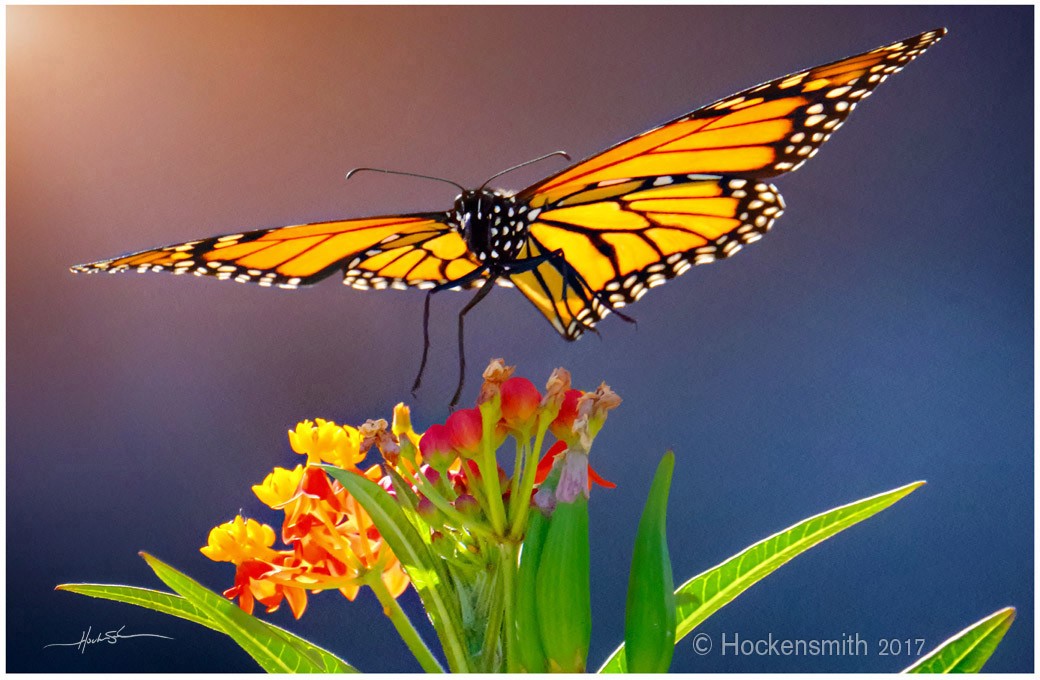
To say that the Monarch’s stages of development, patterns of migration, survival instincts, and self-destructive reproduction propensities are mysterious and perplexing is an understatement. The above photo is one of 18 images that comprise photographer John Stephen Hockensmith’s The Chrysalis Project, a magnanimous undertaking that artistically depicts the remarkable phenomena of the Monarch butterfly’s life cycle and the ramifications it has for us in the modern world, both social and natural.
Hockensmith’s project was born in September, 2016 when a client gifted him a chrysalis in a small terrarium and asked him to watch the miracle that was about to happen. While he did not actually witness the emergence of the butterfly, it inspired him to pursue and document the wonders of this transformation as an art project. He started by going to an arborist who had a garden in his backyard that served as a way station for Monarchs. There he obtained some milkweed and an additional caterpillar to add to his terrarium. He closely observed the caterpillar as it munched on the milkweed, growing quite large in a relatively short amount of time. It then found a twig, formed a silk connection and went into the hooking stage and molded itself into a chrysalis, the emerald green casing you see on the left—Chrysalis 013. This is when Hockensmith pulled his camera out of the bag and went to work. In its own good time, the chrysalis turned to gossamer as a Monarch butterfly wiggled its way into existence and posed with its ancestor, the caterpillar, in the image on the right—Chrysalis 016.
[row][column md=”6″]
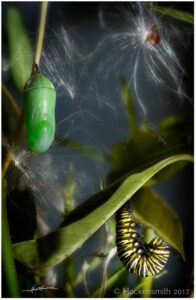
[/column][column md=”6″]
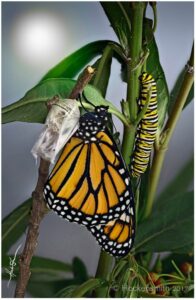
[/column]
[/row]
As he began photographing this transformation in his studio, Hockensmith employed a digital-imaging technique known as photo stacking where multiple images are taken at varying focal lengths at very close range. Then using special software, these images are compilated into a single photograph that results in a particular desired depth of field. In Chrysalis 013, for example, all the key elements—the milkweed leaves, the caterpillar, the chrysalis, and the floating silver strands from the milkweed seed—are in sharp focus despite the distance between them. And Chrysalis 016 exhibits the same compilated depth-of-field qualities as well. These are extraordinary works of art not just for the miracle of nature they so exquisitely portray, but because of the experience, knowledge, and technical skills required to create them.
You may not know that it takes a village to create a work of art, particularly a body of work such as The Chrysalis Project, but it does. On discovering that some Girl Scout groups had created five Monarch gardens in Georgetown within the vicinity of his studio, Hockensmith was able to obtain more caterpillars, harvest more milkweed, and build a larger terrarium so that by the end of the season he had witnessed ten caterpillars become butterflies. He was then inspired to take his camera into these gardens and those at Buckley Wildlife Sanctuary near Frankfort to observe and capture Monarchs in various stages of flight, landing on milkweed, and interacting with each other and other insects. He said, “It was an alien world that emerged in front of me that was magical, mystical, and scientific as well as undefinable, really.”
[row][column md=”6″]
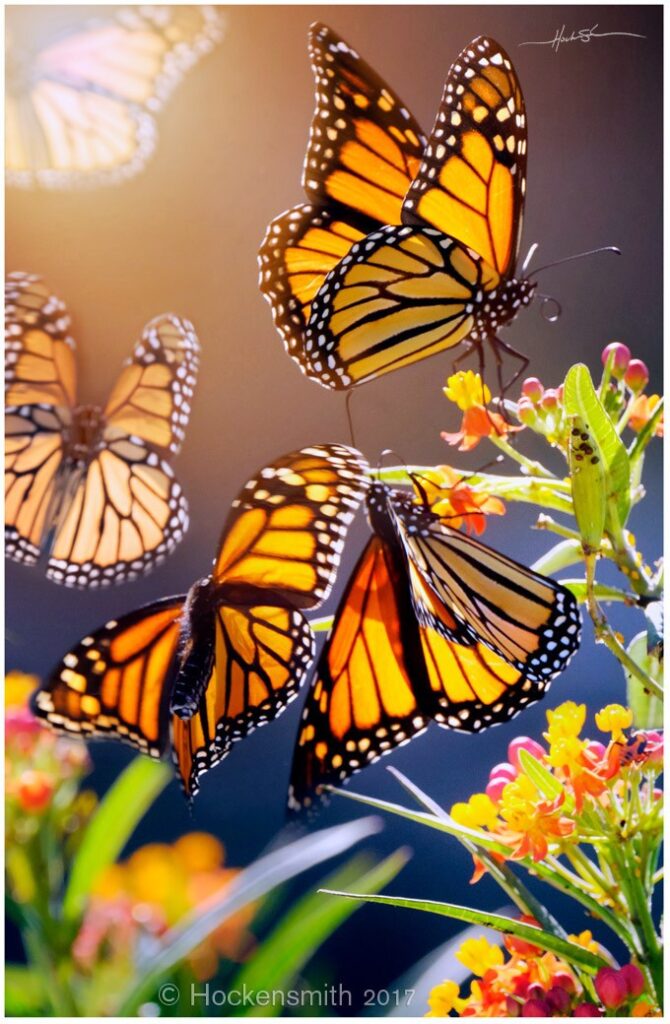
[/column][column md=”6″]
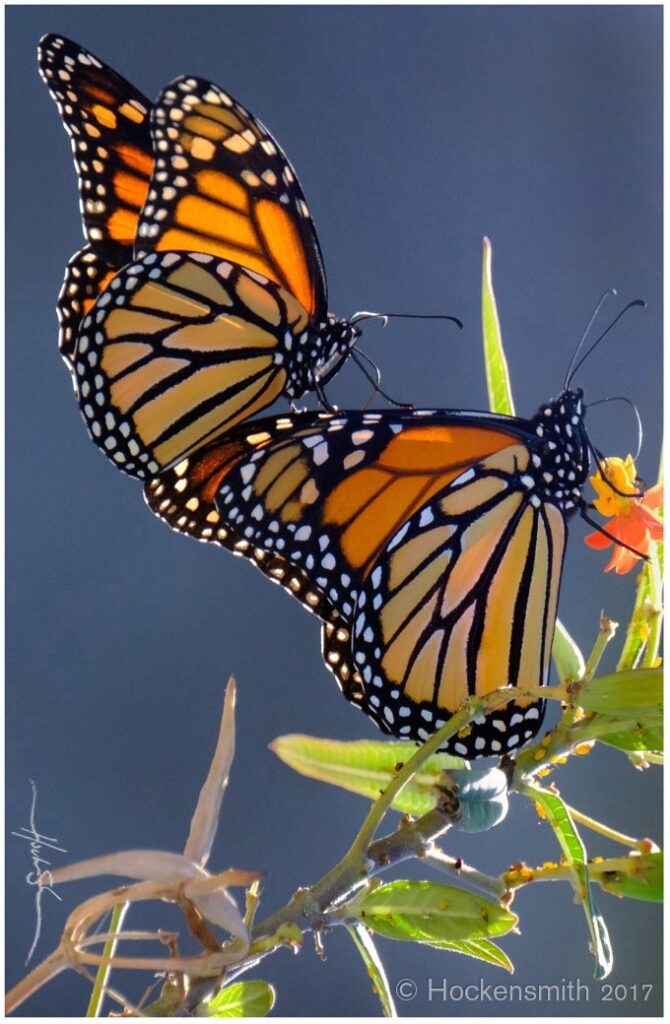
[/column]
[/row]
As you gaze on Chrysalis 002 and 003, the brilliant ethereal glow and translucent fluidity of these images make you think these dainty nectarines could easily flit out of sight at the blink of an eye. Seizing moments like this is more than just a matter of determination. It requires instinct and passion, a lot of patience, and a willingness to explore and seek out the feeding and breeding grounds of these transitory spirits of nature.
It’s always advantageous to be in the right place at the right time, but that’s not the whole of it. Hockensmith used the latest mirrorless technology and long, light-weight lenses in learning to track and capture the butterfly and other insects in flight. The photographer’s intuition and ability to anticipate motion, however, are elemental factors that cannot be mathematically or logically determined. It’s a matter of prescience. In Chrysalis 017, the Monarch has landed on a Zinnia and waits its turn to partake of the sweet nectar. This is obviously a stop-action shot, but the essence of what you see continues long after the shutter has been released. These co-existing partners of pollination commune, feed, and then move on to continue to fulfill the purpose of their short lives.
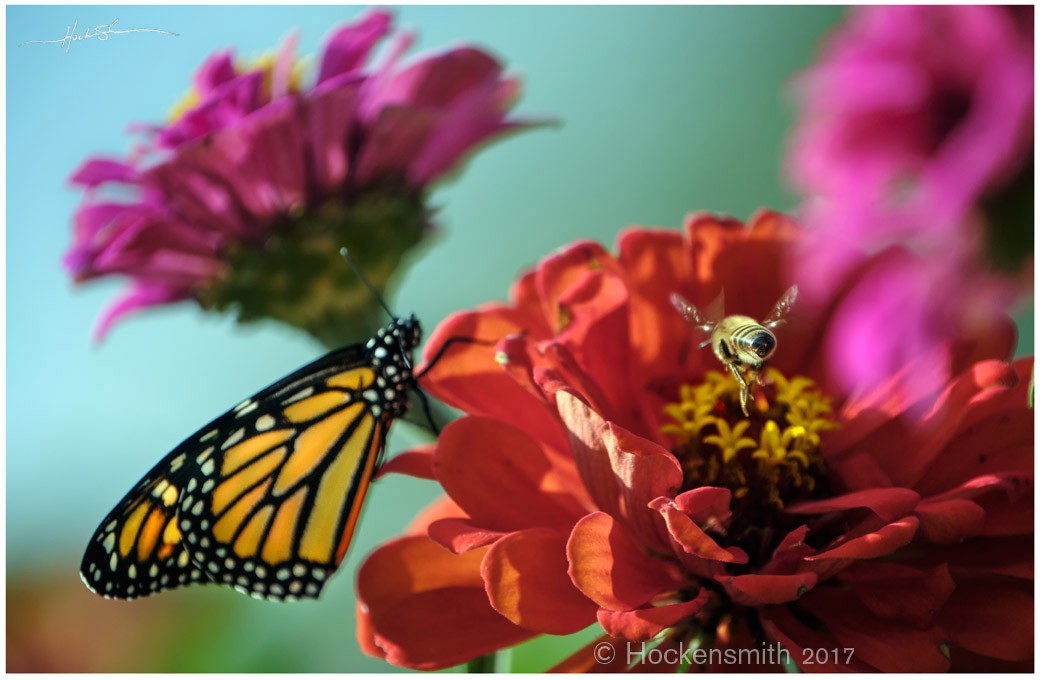
When the Monarchs in his terrarium matured, Hockensmith released them one by one out the back door of his studio saying to each as it took flight, “I’ll see you in Mexico.” His experimentation and intense interest in these delicate-winged creatures led him to study their migration habits from the Northeastern United States and Canada to eight different sanctuaries in the Sierra Madre Mountain Range of Central Mexico where they gather in ornamental fir trees, the oyamel, on the top of these mountains. He chose the sanctuary of Cerro Pelon in Mancheros and planned his own migration southward for mid-January. He could not be fully prepared for what lay ahead of him and he could only dream that one of these bronze angels had once inhabited his studio.
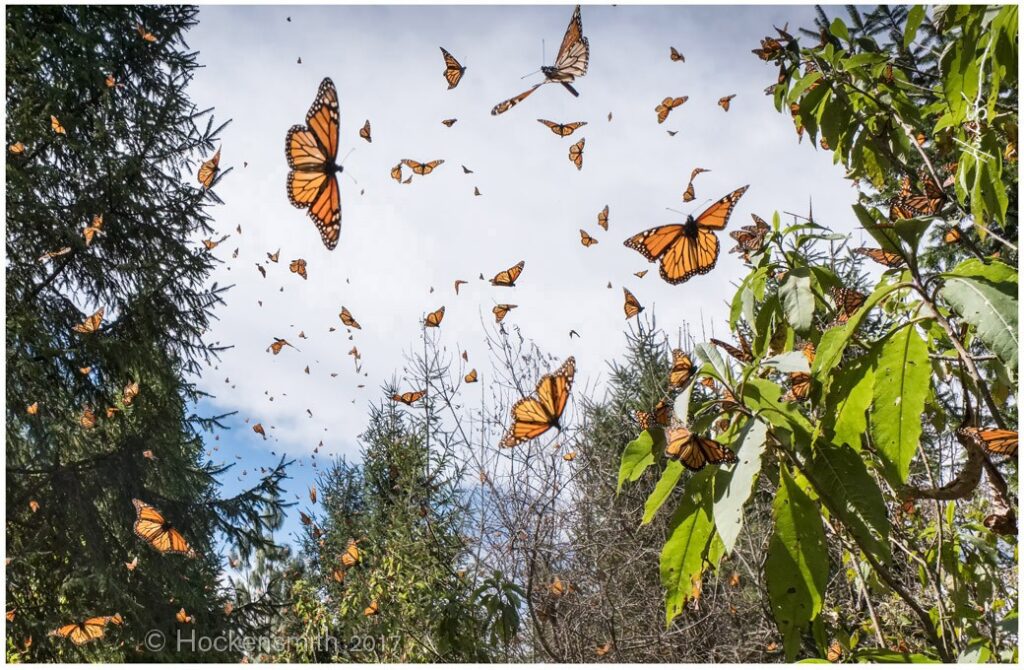
After his arrival in Cerro Pelon, Hockensmith rode up into one of the sanctuaries on a small Spanish Mustang known for its sure-footedness on the mountainside. Waiting for him at the top of the mountain was the third generation of Monarchs that had completed the relay of the migration north the year before. They dangled in the fir trees in such great numbers that the limbs sagged downward with their weight. Pretty amazing when you consider that the average adult Monarch weighs only half a gram. These trees are critical to their survival, sheltering them from inclement weather and sudden drops in temperatures. The ability of the Monarchs to even move is slowed down considerably at 55 degrees or below. But as the temperature rises, they too rise like small kites that have been freed from entanglement and begin their migration northward for another season.
Hockensmith commented that “It appeared as a fantasy to be there with a camera and to be able to record this phenomenal event. It made me want to incorporate it somehow into the seasons of my own life, to photograph and punctuate the existence of the Monarch in its Kentucky environment, to create my own butterfly gardens, and to have my own communion with these kings and queens of the insect world.” The citizens of the region celebrate the annual return of the Monarchs on “The Day of the Dead” and make offerings to the souls of their departed ancestors who have come back to commune with them. This is oneness with nature at its best.
[row][column md=”6″]
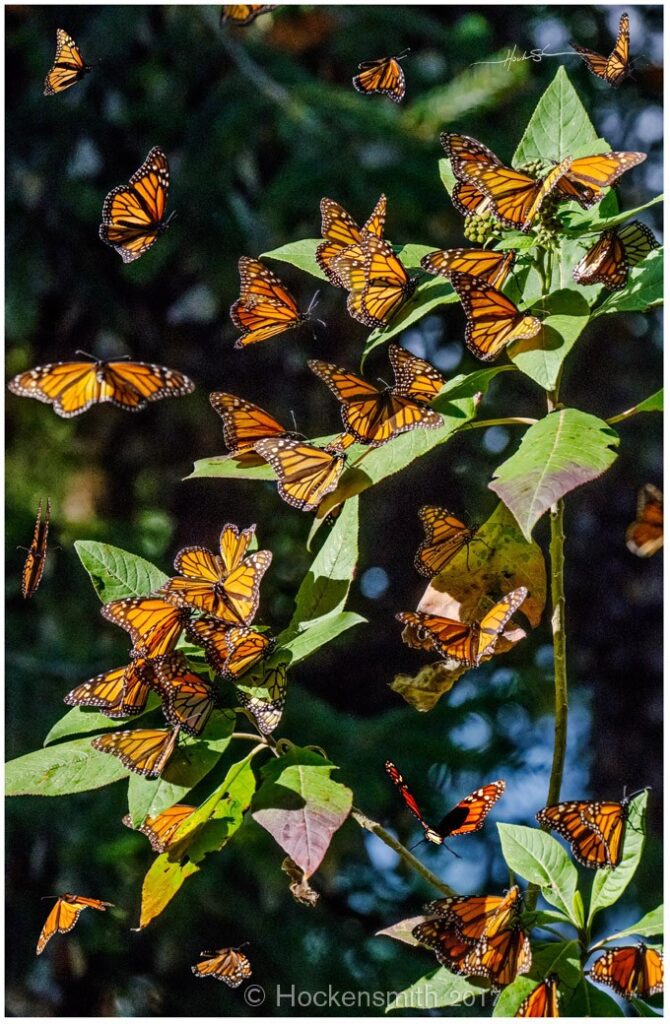
[/column][column md=”6″]
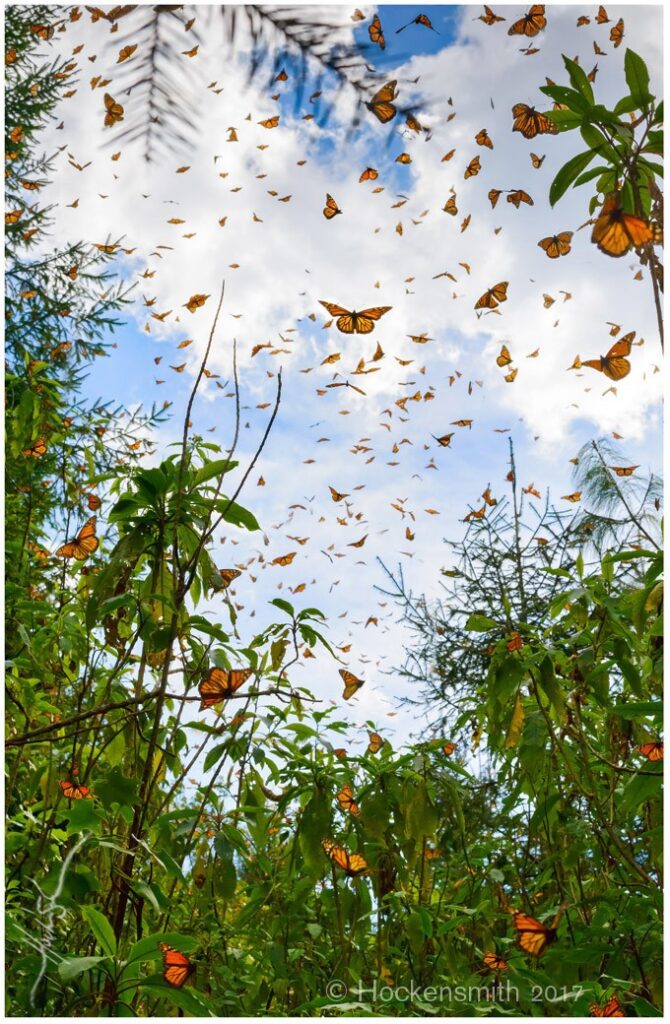
[/column][/row]
Each generation of Monarchs that migrates back to North America and Canada in the spring lives only a couple of months at most. Once the female lays her eggs on the milkweed leaf, she dies and her offspring continue the journey. The third generation, however, that returns to Mexico in the fall may live as long as seven to eight months, providing they survive the 2,000 to 3,000-mile flight in order to begin the cycle all over again.
Monarchs have few natural enemies other than the elements. Their biggest threat is humankind. Although the sanctuaries in Mexico are protected by the government, illegal logging is quickly destroying large portions of their habitat. Also, the use of herbicides, such as Roundup, is decimating milkweed, the only plant on which the Monarch lays its eggs and on which the caterpillars feed. Then there is climate change. The Natural History Wanderings blog site recently posted (February 10, 2017) a release from The Center for Biological Diversity declaring that the Monarch population has dropped off by one-third in 2016 alone, and decreased by 80 percent over the last few decades (naturalhistorywanderings.com). It’s probably safe to say the Monarch butterfly is an endangered species.
The prophetic words of the Romantic poet, William Wordsworth, written over 200 years ago still ring true:
The world is too much with us; late and soon,
Getting and spending, we lay waste our powers;
Little we see in Nature that is ours;
We have given our hearts away, a sordid boon!”
So what Hockensmith demonstrates through his art and his first-hand experience is that we can perhaps regain our hearts—that the story of the Monarch’s migration is indeed one of beauty, wonder, endurance, and, yes, sadness. But above all, it is one of hope—the same hope that Chrysalis House has for the disenfranchised mothers and children who are in its care. In the spirit of rebirth and renewal, Hockensmith has made a commitment to donate a portion of the proceeds from The Chrysalis Project to Chrysalis House. He stated that the integral philanthropic component of his project “metaphorically illustrates the transformational nature of how humans can escape some of the difficult positions we find ourselves in as life changes and insists that we become something other than what we are.”
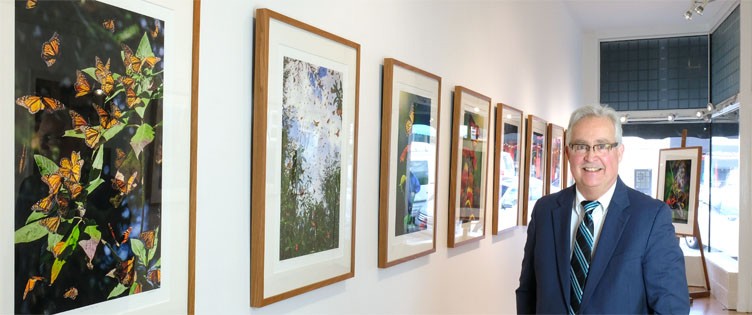
Although the venues are yet to be determined, The Chrysalis Project will be travelling beyond the gallery walls to foster awareness throughout the state regarding the important role these cross pollinators (butterflies and honeybees) play in our lives. The official launch party is on April 6th from 5:30-8:30 p.m. at Fine Art Editions, 146 East Main Street in Georgetown, Kentucky.
May the great spirit of the Monarch move you to come see this astonishing art work while indulging yourself in some wine and light hors d’oeuvres. And trouble yourself to memorize this line from another great Romantic poet, John Keats: “A thing of beauty is a joy forever!” After seeing this show, which runs through June, you are not likely to forget it.
The museum-quality, limited edition prints of the 18 images included in this exhibit are available framed (31 x 41½ inches) or unframed (19½ x 30 inches), and you can sneak a peek at finearteditions.net.
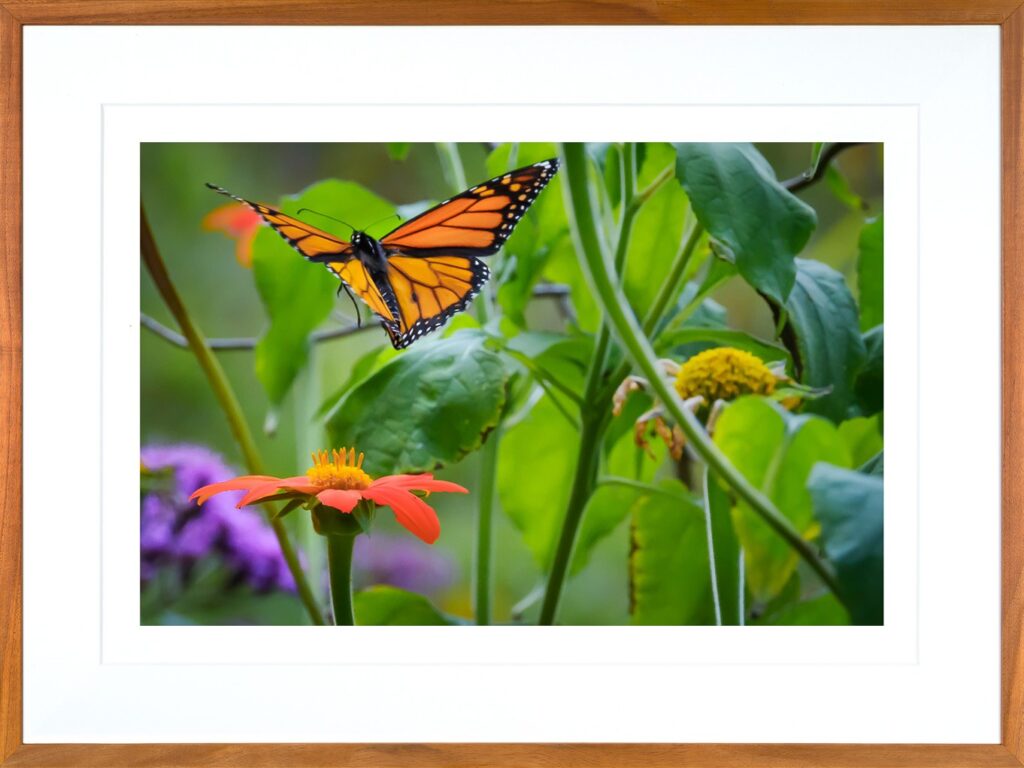
(All images courtesy of Fine Art Editions)




